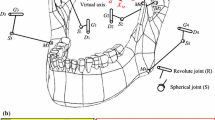Abstract
The human vocal mechanism has a singularity near the vowel /ee/. Investigating the role of redundant articulatory parameters in speech transitions near this singularity involves 1) applying curve-fitting methods developed for robot motion planning to the complete tongue outline, 2) calculating resonance frequencies from a geometric construction of streamline flow in a 2-d vocal tract, and 3) solving the inverse articulatory-to-acoustic transformation by optimization constrained by x-ray measures of pellet markers on the tongue, jaw, and lips. Time histories of articulatory parameters of the word /used/ from two subjects show an absence of compensation for the effect of the singularity on the shape of the formant transitions.1
Access this chapter
Tax calculation will be finalised at checkout
Purchases are for personal use only
Preview
Unable to display preview. Download preview PDF.
Similar content being viewed by others
References
Atal, B. S., Chang, J. J., Mathews, M. V., and Tukey, J. W. (1978) Inversion of articulatory-to-acoustic transformation in the vocal tract by a computer-sorting technique, J. Acoust. Soc. Am. 63, 1535–1555.
DiCaprio, F., Khanuja, S. S., Stanisic, M. M., and Duta, O. (1991) Singularity free six degree of freedom manipulator, in Stifter S. and Lenarcic J. (eds.), Advances in Robot Kinematics, Springer-Verlag, 128-135.
Fant, G. (1980) The relations between area functions and the acoustic signal, Phonetica 37, 55–86.
Harshman, R., Ladefoged, P., and Goldstein, L. (1977) Factor analysis of tongue shapes, J. Acoust. Soc. Am. 62, 693–707.
Loo, M., Hamidieh, Y. A., and Milenkovic, V. (1990) Generic path control for robot applications, Robots 14 Conf. Proc., SME, Detroit, MI, USA, 10/49-10/64.
Loo, M. and Milenkovic, V. (1987) Multicircular curvilinear robot path generation, Robots 11 Conf. Proc. and 17th Internat. Sympos. Industrial Robots, SME, Chicago, Il, USA, 18-19 to 18-27.
Milenkovic, P. H. (submitted) Articulatory model for determining the vocal tract area function from point-parameterized data, J. Acoust. Soc. Am..
Milenkovic, V. (1979) Computer synthesis of continuous path robot motion, Proc. 5th World Cong. Theory of Machines and Mechanisms, ASME, Montreal, Canada, 1332-1335.
Milenkovic, V. (1987) New nonsingular robot wrist design, Proc. 17th ISIR and Robots 11, SME, 13-29:13-42.
Milenkovic, V. and Milenkovic, P. H. (1996) Tongue model for characterizing vocal tract kinematics, in Lenarcic, J. and Parenti-Castelli, V. (eds.), Recent Advances in Robot Kinematics, Kluwer, Dordrecht, 217-224.
Peterson, G. and Barney, H. (1952) Control methods used in a study of the vowels, J. Acoust. Soc. Am. 24, 175–184.
Press, W. H., Flannery, B. P., Teukolsky, S. A., and Vetterling, W. T. (1989) Numerical Recipes in Pascal: The Art of Scientific Computing, Cambridge University Press, Cambridge.
Ramo, S., Whinnery, J. R., and Van Duzer, T. (1965) Fields and Waves in Communication Electronics, John Wiley, New York.
Story, B. H. and Titze, I. R. (1996) Parameterization of vocal tract area functions by empirical orthogonal modes, NCVS Status and Progress Report 10, 9–23.
Streeter, V. L. (1948) Fluid Dynamics, McGraw-Hill, New York.
Westbury, J. (1994) X-ray Microbeam Speech Production Database User’s Handbook, Madison, WI, USA.
Author information
Authors and Affiliations
Editor information
Editors and Affiliations
Rights and permissions
Copyright information
© 1998 Springer Science+Business Media Dordrecht
About this chapter
Cite this chapter
Milenkovic, P.H., Milenkovic, V. (1998). Coordination of Redundant Articulatory Parameters Near a Singularity in the Vocal Mechanism. In: Lenarčič, J., Husty, M.L. (eds) Advances in Robot Kinematics: Analysis and Control. Springer, Dordrecht. https://doi.org/10.1007/978-94-015-9064-8_50
Download citation
DOI: https://doi.org/10.1007/978-94-015-9064-8_50
Publisher Name: Springer, Dordrecht
Print ISBN: 978-90-481-5066-3
Online ISBN: 978-94-015-9064-8
eBook Packages: Springer Book Archive




